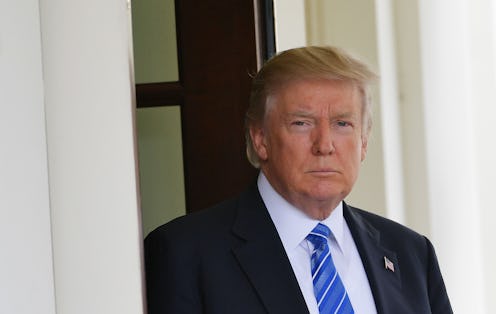News
The White House Won't Commit To Joining Congress In Condemning White Supremacists

The Senate and House just proved that bipartisanship isn't extinct yet. Voting on a resolution condemning the violence and bigotry on display in August from white supremacists and neo-Nazis in Charlottesville, Virginia, both chambers passed the measure unanimously. It now heads to the desk of President Trump, forcing a signature of approval or veto. There's no POTUS in living memory for whom this would be a challenging decision, but it remains unclear what the 45th president will do about it. Asked Tuesday whether or not Trump would sign the resolution condemning white supremacy, a White House spokesperson said there were "no announcements at this time."
That response leaves open the possibility of Trump signing this congressional resolution, of course. However, it's also dodging a question that has an obvious, easy, and unqualified answer. Checking with the boss before commenting on major legislation is understandable, but the fact that a White House spokesperson could not make an assumption on Trump's response to an opportunity to condemn white supremacy is striking.
The resolution goes beyond a verbal condemnation. Congress also exhorts the White House to "use all resources available to the President and the President's Cabinet to address the growing prevalence of those hate groups in the United States."
This isn't the first time Trump has waffled on taking a firm stance against white supremacy. For most casual news consumers, that moment came during the 2016 Republican primary during an interview on CNN's State of the Union with Jake Tapper. Asked point-blank if he would condemn David Duke, the well-known former grand wizard of the Ku Klux Klan, Trump retorted, "you wouldn't want me to condemn a group that I know nothing about." Then-candidate Trump evaded Tapper's direct specification of the KKK, refusing no less than four times to disavow support from an organization famous for murdering and terrorizing black Americans.
Trump's approach with Tapper was echoed in how he responded in the wake of the racially motivated violence that took place in Charlottesville, Virginia, on Aug. 12. Trump infamously condemned the violence "on many sides"; critics said his statement posited a moral equivalency between the white supremacists and neo-Nazis fighting in defense of their bigoted ideas and those who showed up to protest against them. Trump also said there were "some very fine people" amongst the Confederate flag bearers chanting anti-Semitic slogan, sparking more outrage.
After taking a major PR hit for his comments, Trump gave a scripted speech in which he much more forthrightly condemned white supremacists. However, much of that speech was nullified at Trump's subsequent rally in Arizona. Less than two weeks after issuing an outright condemnation of white supremacy, Trump defended his original remarks and once again blaming the "fake news" media for their unfair portrayal of him. Trump also accused those advocating for the removal of confederate statues as wanting to take away "our culture," "our history."
It is perhaps with these events in mind that Congress chose to send their latest resolution to Trump's desk. Normally, the Senate and House use resolutions as a way to express their own opinion on a current matter. How they weigh in doesn't involve the president whatsoever.
However, the resolution condemning white supremacy and requesting that resources be devoted to combating it was specifically structured as a joint resolution requiring a presidential signature or veto. Whether he wants to or not, Trump is now compelled to take a public stance, one way or the other.
Condemning white supremacy isn't complicated and shouldn't be hard. But if the past is any indication, for Trump, signing this resolution may prove more challenging than it should be.